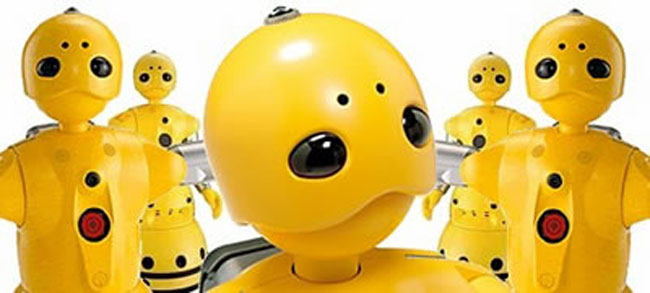Boy, These Receptionists are Real Robots!

The Wakamaru receptionist robot has finally found some work. People Staff, a large temporary staffing agency based in Nagoya, Japan, announced that it has "hired" ten of the bright yellow robots as dispatch workers (see photo). They are ready to work at businesses in the Tokai area of central Japan.
The receptionist robots are one meter tall; they move their 66 pound bodies around on wheels. The bots were first developed by Mitsubishi in 2003 as a companion robot; interaction with human beings is its specialty. The home version allows the bot to connect to Internet news (to obtain conversational material); it also allows remote observation via Wakamaru's cameras.
Frankly, these receptionist robots don't have much of a work history; nevertheless, here's a brief resume:
- Face recognition (search for and follow faces)
- Basic manual tasks
- Good listener (voice recognition capabilities)
- Good verbal skills with customers (vocabulary of 10,000 words)
- Sings cheerful songs
- Escort visitors to different destinations within your office building.
The Wakamaru robot is less cost-effective for short engagements (probably $1,000 per day); however, it is expected that annual contracts could run as little as $25,000. This is comparable with the cost of a human temporary worker.
Although it is less mobile, the Wakamaru robot's chief rival, the Actroid DER2 fembot, has a humanoid appearance and a longer work history. The South Korean fembot EveR2-Muse has more public exposure as a singer. No word on how well Wakamaru works with fembots as yet.
(This Science Fiction in the News story used with permission from Technovelgy.com - where science meets fiction.)
Get the world’s most fascinating discoveries delivered straight to your inbox.
- Vote for your Favorite Real Robot
- Image Gallery: Cutting Edge Robots
- All About Robots


